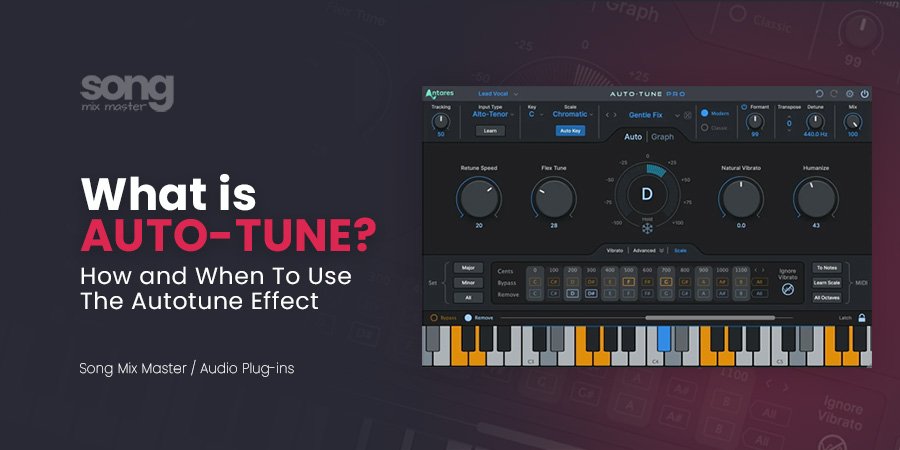Auto-Tune is audio processing software developed by Antares company to correct the pitch of a vocal recording. The software detects the incorrect note and automatically adjusts it to the correct pitch, using a technique called “time and frequency processing.”
When a voice is recorded, it becomes an audio signal that can be visualized on a waveform graph. Autotune processes this audio signal and divides it into small sections called “frames.” Within each frame, Autotune analyzes the fundamental frequency of the sung note and compares it to the musical scale.
If the sung note’s frequency is off-pitch, Autotune automatically adjusts it to the correct pitch. This process occurs in real-time, allowing you to hear the Autotune effect while recording. Autotune also offers the option to adjust the pitch correction speed. Setting it to a slow speed can achieve a subtle effect, while a faster speed can create a more pronounced and noticeable effect.
Also read: Ensuring a Successful Recording Session
In addition to pitch correction, Autotune can create creative effects in vocals, such as the popular T-Pain or Cher effect. To achieve this, the software is adjusted to unconventional scales, and a faster pitch correction speed is used to create a robotic or futuristic sound.
In summary, Autotune is an audio processing software that uses time and frequency processing to correct the pitch of a vocal recording in real-time. It can also be used to create creative vocal effects.
The Best Technique for Tuning Your Voice Using Autotune
Let’s talk about a technique I’ve developed, one that has led artists to work differently. After recording, during the mixing phase, Melodyne or a similar tool is often needed to tune the vocals. This process can be quite tedious and frustrating for the vocalist. It can turn an artist into something less real, almost artificial. But why artificial? They sang out of tune, and the mixing engineer had to correct it post-recording. So, what did the artist contribute? Not much, to be honest.
Now, let me introduce you to what I call the “REAL” technique. Why “REAL”? Because I believe Autotune is an instrument for the voice, much like a guitar is for hands. Without the voice, Autotune can’t make a sound, just as a guitar won’t make a sound without skilled hands. To make Autotune work for you, you need to know the technique.
Just like playing the guitar well makes it sound incredible, singing with Autotune and understanding how it works can yield fantastic results.
The technique involves applying Autotune during your recording sessions so you can hear the “TUNE” effect through your headphones. You should set it to 100% effect to monitor the breaks you create with this tool in real-time. If those “TUNE” breaks sound amazing at 100% effect, imagine how great they’ll sound when you reduce the effect level to 50%, 60%, or 70%.
Your voice will sound natural and in tune. However, it’s not all sunshine and roses. To make your Autotuned voice sound good, you must master Autotune. It’s a vocal instrument that requires the artist to sing according to its tune to sound perfectly in tune.
Many artists use Autotune, but it sounds terrible because they don’t understand how to use it effectively. This technique is about making Autotune sound incredible when the artist uses it. You’ll become a more “REAL” artist if you achieve fantastic Autotune breaks during recording. Some artists use Autotune, and it still sounds awful. Practicing this technique more can change that.
Another advantage of this technique is that when you perform live and use Autotune, your vocals will never sound bad because you’ve mastered this tool. Some artists perform live with Autotune and sound terrible, which is a bit sad. If they practiced more, the outcome could have been different.
Furthermore, this vocal pitch technique allows you to have a beautifully tuned song you can sing along to as you listen. Your ears will become attuned to the tuning and sound of your voice, corrected by a vocal tuning processor.
You can practice while listening, paying close attention, and maybe, eventually, sing it live without Autotune because you’ll know how to do it. Studying music is great, but this technique is for self-taught artists like myself.
Also, read Antares Auto-Tune vs. Waves Tune Real-Time and Best Free Autotune Plugins.



Disclaimer: Any references to any brands on this website/webpage, including reference to products, trademarks, brands and companies, are provided for description purposes only. We don't have any association with or endorsement by these brands or companies. Some of the links on our blog may be affiliate links. This means if you click on these links and make a purchase, we may earn a commission at no extra cost to you.
Check Out My New Fabfilter Pro-Q3 Presets Pack!
You may also like to read...
How To Inverse EQ & Match EQ Using Fabfilter Pro-Q3
“Glue” Compression – Best Glue Compressors for Mastering
Choosing the Right Computer for Your Home Recording Studio
The Essential Guide to Audio Normalization
My Advanced Techniques & Tips for Mixing and Mastering
Review of the Empirical Labs EL8 Distressor Plugin by UAD
Book My Mixing & Mastering Services